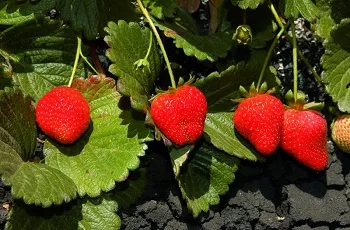

Serenade ASO
Serenade ASO is a foliar fungicide for the reduction of damage caused by various fungal diseases in a wide range of agricultural and horticultural crops.
Product details
Product Profile
Important Information
Restrictions
For crops grown under permanent protection with full enclosure:
Reasonable precautions must be taken to prevent access of birds, wild mammals and honey bees to treated crops.
To minimise airborne environmental exposure, vents, doors and other openings must be closed during and after application until the applied product has fully settled.
Do not apply using irrigation equipment.
Get more ways to improve crop quality
It's time to enhance your crop protection. Use Serenade ASO biological fungicide to boost marketable yield in protected strawberries and a wide range of other crops covered by EAMUs.
Serenade ASO principally targets Botrytis losses. However, with a multi-site physical mode of action and the ability to trigger the plant’s own defences, Serenade ASO has been shown to offer broad-spectrum activity against other important fungal and bacterial diseases on the plant and in the soil, as well as resistance management and plant health promotion benefits.
Flexible
You can apply Serenade ASO as a stand-alone, but for optimum efficacy and resistance management, it is best used in IPM programmes to support conventional fungicides. Moreover, an exemption from residues and a zero-day pre-harvest interval (PHI) mean that it is easy to meet end-of-season customer requirements.
Compatible
Serenade ASO fits your current practices. It can be used as a tank-mix partner with many crop protection and nutrient products, is approved by the Institute for Marketecology (IMO) for organic use and supported by the Soil Association (SA) and Organic Farmers & Growers (OF&G)*. Storage is straightforward – there are no specific requirements – and Serenade ASO shows excellent safety with a wide range of beneficials.
Proven
UK soft fruit growers have successfully integrated Serenade ASO in their fungicide programmes for many years. More recently, it has also become integral to IPM on much of the UK's tomato production for Botrytis and powdery mildew control.
Serenade ASO is widely used in many areas of leafy salad and baby leaf production - indoor and out, conventional and organic. It's now also a mainstream treatment for carrot cavity spot (Pythium spp.) control and has a strong, growing following in many countries for protecting potato yield and quality where Rhizoctonia is present.
* Contact your organic certification body before use for current approval status.
Foliar application
During fermentation, Serenade ASO's beneficial bacteria produce a range of anti-fungal biological compounds including a group kown as lipopeptides. The lipopeptide profile of this biological chemistry is unique to the specially selected strain of Bacillus in Serenade, QST 713, and is not shared by other B. subtilis or B. amyloliquefasciens strains found in alternative products.
For foliar uses, the lipopeptide component of the biological chemistry is most important. On contact, these lipopeptides disrupt the cell membranes of the pathogen, resulting in physical breakdown of its cells. This mode of action is unique to fungicides based on B. subtilis and B. amylioquefasciens strains and is recognised by the Fungicide Resistance Action Committee (FRAC) as Code 44.
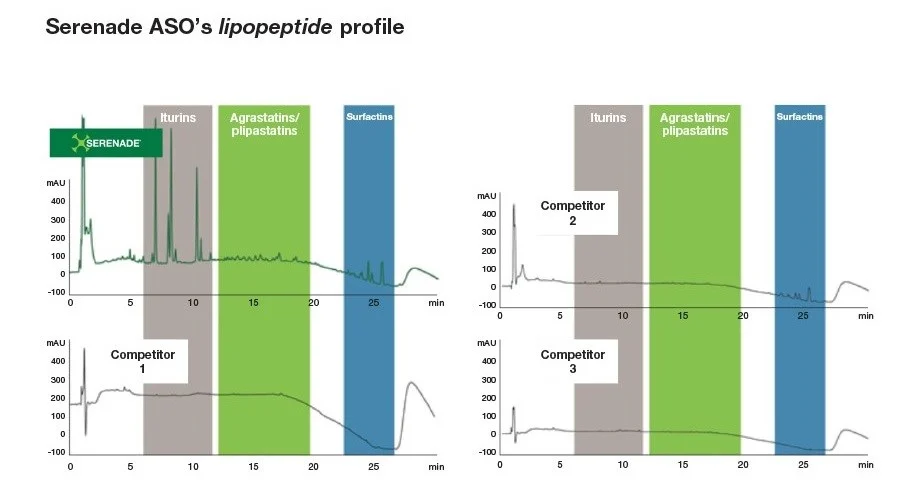
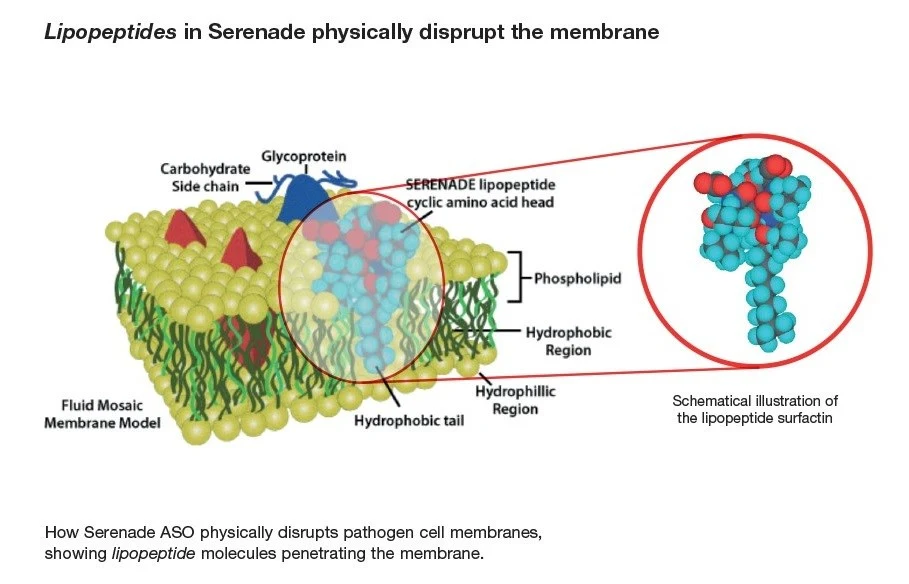
Soil application
Serenade ASO actively colonises roots, forming a protective physical barrier against soil diseases, such as Pythium spp. This barrier grows along with the roots, resulting in extended periods of root protection. As a result, crops can benefit from enhanced plant health and higher marketable yields.
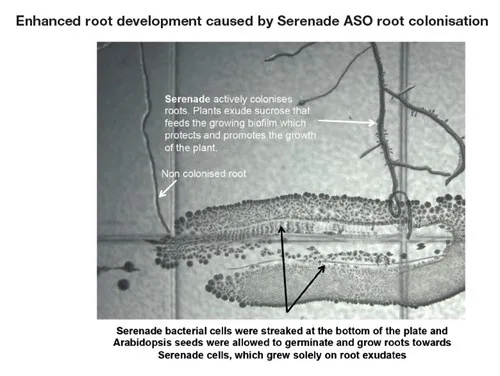
Key characteristics
Contact-active
The different classes of lipopeptides within the biological compounds that Serenade ASO produces act on fungal pathogens in several contact-active ways. Serenade ASO is not systemic within the plant.
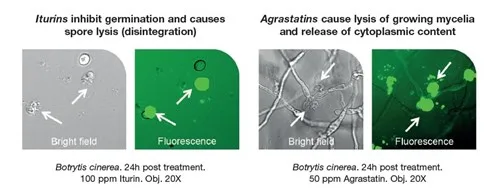
This membrane disruption mode of action is especially important when Serenade ASO is used alongside a second fungicide, as it may allow the second fungicide better access to the pathogen.
Preventative
Once fungal diseases are established in a plant, contact-acting fungicides such as Serenade ASO often have insufficient curative activity to eliminate the pathogen. Preventative applications are therefore vital and application intervals of 7 days or less may be required to prevent fungal re-infection.
Systemic resistance to disease
Serenade ASO has been shown to induce systemic resistance responses in treated plants. In addition to contact control , it primes plants to defend themselves against pathogens. The induced response results in reduced disease and other measurable effects including activation of the salicylic acid (Systemic Acquired Resistance) and gibberellic acid (Induced Systemic Resistance) pathways - observed in both foliar and soil applications.
Major benefits
Broad-spectrum
Because the MoA physically disrupts pathogen membranes, Serenade ASO has been shown to be active against a broad spectrum of diseases. In protected strawberries, Serenade ASO reduces fruit damage caused by Botrytis cinerea, but trials in this and many other crops also show useful activity against diseases such as powdery mildews, Alternaria and Sclerotinia.
Another group of biological compounds produced by Serenade ASO has been demonstrated to have efficacy against bacterial diseases including Clavibacter, Ralstonia, Erwinia, Pseudomonas and Xanthomonas species. Some of these compounds compete for an enzyme that pathogenic bacteria need to build their cell walls.
Anti-resistance
Serenade ASO is at inherently low risk for the development of resistance. As the major target is the cell membrane, no simple mutation can result in pathogen resistance. In fact, Serenade AO's multiple MoAs are great resistance breakers.
Mutual relationship
The beneficial bacteria in Serenade ASO form a mutual relationship with the plant in the root zone. The root exudates feed the growing bacillus biofilm, which in turn protects and promotes the plant's health through production of its many biological compounds.
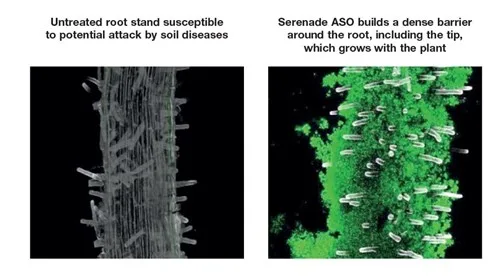
Enhanced Root Structure
The colonisation of the roots by Bacillus subtilis not only produces anti-fungal, anti-bacterial and plant health stimulating compounds, but also produces plant growth hormones. These trigger enhanced root development, with visible increases in root laterals and fine root hair development and can speed early-season growth.
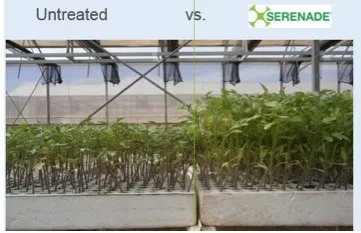
Improves nutrient mobilisation and uptake
Serenade ASO can improve nutrient solubilisation in soil, allowing plants more efficient access to essential nutrients like phosphate and potassium as well as the micronutrients manganese, calcium, boron, zinc and silicon. Improved nutrient availability within the plant following Serenade ASO applications has been seen to result in enhanced crop quality and shelf life of fresh produce.
Roots colonised by Serenade ASO are denser and have more lateral roots and longer root hairs. This increased root surface area gives improved phosphorus uptake, availability of nutrients, water absorption and anchorage - all leading to stronger, healthier plants.
Serenade ASO is a naturally occurring biological control agent suitable for use in organic growing systems. It is approved for use in organic farming under EC Regulation No.834/2007 & 889/2008 by IMO Switzerland. However, it is advisable to check with your organic certification scheme before use.
Strawberry (protected)
Apply in a water volume of 200–1000 litres of water per hectare according to crop density.
Botrytis control usually requires a programme of fungicide sprays and Serenade ASO may be used as part of such a programme. Serenade works preventatively with a contact mode of action, so for successful control of Botrytis it is vital to achieve complete cover of all flowers and fruitlets throughout the blossom period. Sprayers should be set up in such a way as to achieve maximum cover on these parts, with sprays directed over the crop rows, not applied overall.
The first spray of a Botrytis fungicide programme should be made from first flower set (BBCH 55). A minimum of five days should fall between applications of Serenade.
Programme planning
The diagrams below illustrate how Serenade can be integrated with the use of conventional crop protection chemistry in strawberry disease control programmes based on the following principles;
Begin with the strongest product – Luna Sensation – for a clean start at the critical flowering period and repeat application when under periods of higher disease pressure.
Use Serenade between or alongside applications of conventional chemistry, under periods of lower disease pressure and later when plants are successively flowering and fruiting.
Incorporate and alternate conventional chemistry with different / complimentary modes of action.
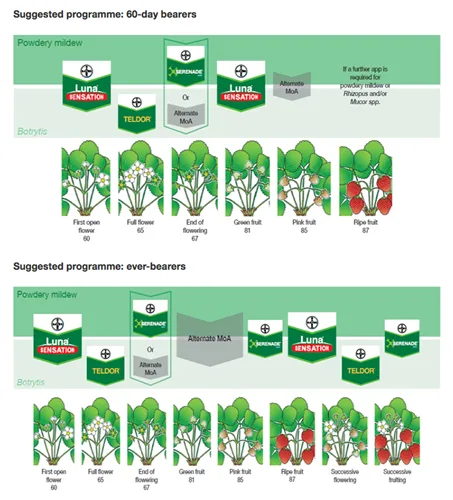
Lettuce (Permanent protection with full enclosure)
Apply in a water volume of 200–1000 litres of water per hectare according to crop density.
Botrytis and Sclerotinia control usually require a programme of fungicide sprays and Serenade ASO may be used as part of such a programme. Apply from 3 true leaves (BBCH 13) from the early onset of disease. Serenade works preventatively with a contact mode of action, so for optimum control it is vital to achieve complete cover when spraying. A minimum of five days should fall between applications of Serenade.
Tomato, pepper and aubergine (Permanent protection with full enclosure)
Apply in a water volume of 200–1500 litres of water per hectare according to crop density.
Botrytis control usually requires a programme of fungicide sprays and Serenade ASO may be used as part of such a programme. Apply after the 3rd leaf on the main shoot has unfolded (BBCH 13) from the early onset of disease. Serenade works preventatively with a contact mode of action, so for optimum control it is vital to achieve complete cover when spraying. A minimum of five days should fall between applications of Serenade.
Qualified recommendation
Limited effectiveness data indicate some control of bacterial spots (Pseudomonas syringae, Xanthomonas campestris) in tomatoes. Conditions of use for tomatoes described in the ‘Important information’ box must be followed.
Users are required to be in possession of the relevant Extension of Use details. Electronic copies of Extensions of Use can be obtained from the Chemicals Regulation Division (CRD) website Extension of Authorisation for Minor Use Database.
Persons using the product to which an Extension of authorisation applies should acquaint themselves with and observe all requirements contained in the Regulation (EC) No 1107/2009, including the duty on the holder of any Extension of authorisation to notify information on potentially dangerous effects, a contravention of which is a criminal offence under those Regulations.
Neither the efficacy nor the phytotoxicity of the product for which this Extension of authorisation has been granted has been assessed and, as such, the user bears the risk in respect of failures concerning its efficacy and phytotoxicity.
EAMU – Foliar spray
These Extensions of Authorisation relate to the use of Serenade ASO as a fungicide for the control of Botrytis spp. They replace uses previously authorised in the Extension of Authorisation notice number 0706 of 2013 which expires on 29 February 2020.
Applications should be made via conventional hydraulic sprayers including air assisted sprayers and hand held sprayers in a minimum of 100 litres water per hectare and a maximum of 1000 litres water/ha, to just before run-off. The product should be applied every seven days or in rotation with a suitable authorised plant protection product.
Neither the efficacy nor the phytotoxicity of the product for which this Extension of Authorisation has been granted has been assessed and, as such, the user bears the risk in respect of failures concerning its efficacy and phytotoxicity.
EAMU – Root drench
This Extension of Authorisation relates to the use of Serenade ASO applied as a root drench.
Apply during drilling, planting or transplanting via hydraulic sprayer or drip feed irrigation lines in 100 to 1000 litres of water depending on method of application as a preventative treatment for various soil borne fungal infections on a wide range of crops as listed below.
Neither the efficacy nor the phytotoxicity of the product for which this Extension of authorisation has been granted has been assessed and, as such, the user bears the risk in respect of failures concerning its efficacy and phytotoxicity.
EAMU – Post-harvest drench
This Extension of Authorisation relates to the use of Serenade ASO as a fungicide for the control of Botrytis cinerea as a post-harvest drench treatment in outdoor cabbage, before storage.
Applications should be made as a drench treatment to harvested cabbages. The treatment solution must not exceed 3% (i.e 30 mls product per litre of spray solution) with a maximum application rate of 20 litres spray solution (600 ml product) per tonne of cabbages.
Application must only take place where any product runoff from the crates/ storage bins and spray equipment washings can be contained e.g. on a biobed or bunded residue collection area. All dilute pesticide waste must be disposed of safely and legally to protect humans, wildlife and the environment, especially groundwater and surface water.
Neither the efficacy nor the phytotoxicity of the product for which this Extension of Authorisation has been granted has been assessed and, as such, the user bears the risk in respect of failures concerning its efficacy and phytotoxicity.
Serenade ASO may be applied as a foliar spray alone or in alternating spray programmes with other registered crop protection products. Alternating with fungicides of different modes of action, along with the use of cultural control methods, is advisable for resistance management.